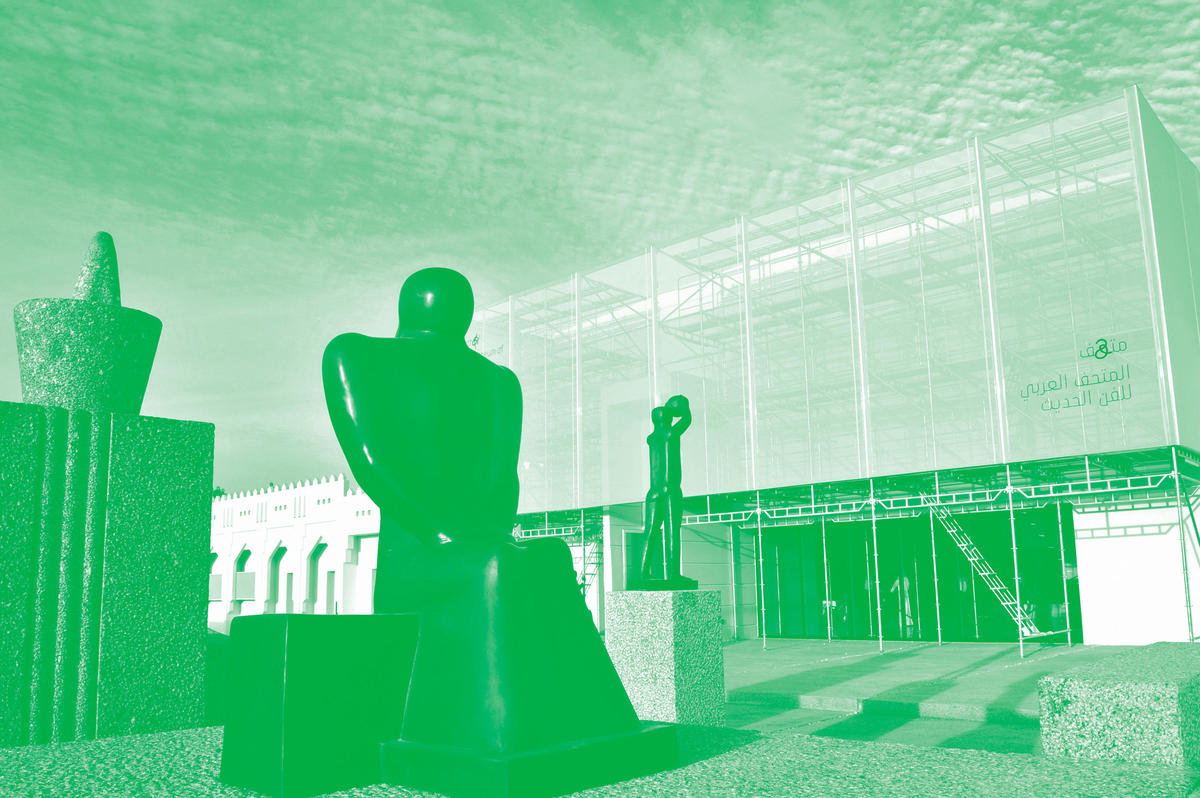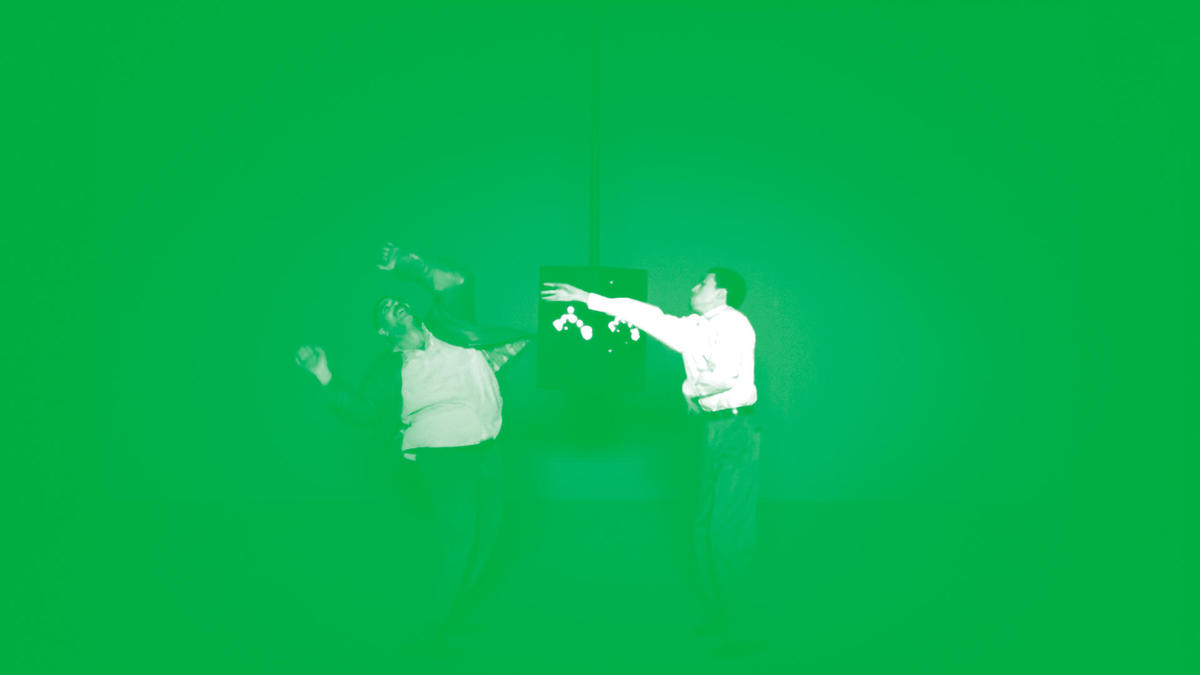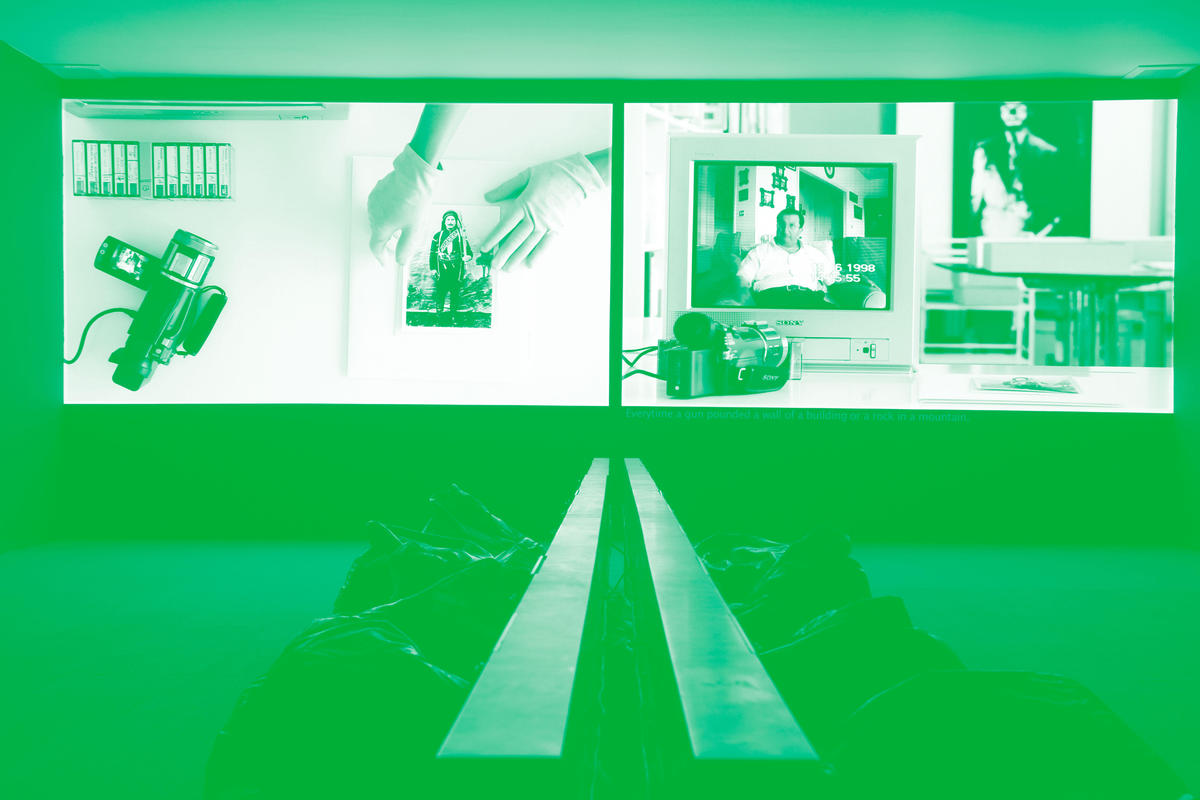
Doha
Sajil: A Century of Modern Art
Mathaf
December 30, 2010–October 1, 2011
Doha
Interventions
Al-Riwaq
December 30, 2010–May 28, 2011
Doha
Told/Untold/Retold
Al-Riwaq
December 30, 2010–May 28, 2011
The new museum of modern art in Doha, known as Mathaf, opened in late December with a list of promises to fulfill. In the months leading up to the inauguration, Mathaf’s principal players embarked on a five-city tour to introduce and drum up support for the museum, in what was billed as a series of conversations. While those conversations were too often quite short, particularly in Beirut and Cairo, they held out a number of interesting prospects, positioning the museum as the mother of all projects, finally addressing the gaps in knowledge, access, and exposure that have blunted the study of modern art in the Arab world.
Mathaf would be the first of its kind, a major hub for research and a center for education of great relevance to the region and to the world. With a collection of more than 6,000 artworks, it would give an encyclopedic view of the different phases through which Arab modernism has passed. With the development of its programming, it would challenge the notion that modernism can only be understood as a western phenomenon. With its first major exhibition, entitled ‘Sajjil: A Century of Modern Art,’ it would explicitly avoid constructing an Arab canon running parallel to or in the shadow of a Western canon. Instead of one narrative, it would offer many in a bid to show that Arab modernism wasn’t an alternative to Western modernism, but that modernism everywhere was part of the same tangled knot, which unraveled differently, and provoked different forms of engagement, in different parts of the world all at once.
Given the prelude, by the time Mathaf actually opened in a refurbished school on the edge of Education City, the air of anticipation was thick. In a way, the museum couldn’t lose. Opportunities to see works by the region’s major nineteenth- and twentieth-century artists are frustratingly rare. The international auction houses that have become active in the Middle East over the last five years have given the market a good shake, but some of the best and most ravishing works remain firmly in private hands. The events staged around Mathaf’s inauguration included a conference organized by AMCA (the Association for Modern and Contemporary Art of the Arab World, Iran and Turkey), and many of the art historians, who lined up to speak were thrilled to wander around ‘Sajjil’ for the first time. Imagine spending years of your life writing a dissertation on an artist whose paintings you had only seen reproduced in books, and then finding yourself in front of those paintings in all their physical, tactile presence.
At the same time, the museum couldn’t win, either. Even if the curators of ‘Sajjil’ — Mathaf’s acting director and chief curator Wassan Al Khudairi, guest curator Nada Shabout and the museum’s head of strategy Deena Chalabi — organized the exhibition according to a narrative that was fragmented, multiple, and occasionally contradictory, they were bound to be criticized by dint of being the first to do so. That isn’t to say that the narrative proposed by ‘Sajjil’ is weak, just that any narrative would have been challenged, and that is precisely Mathaf’s point. During the museum’s pre-opening presentation in Beirut, Chalabi characterized ‘Sajjil’ nicely as “an invitation to research.” As Khudairi explained further: “There’s still so much to be done on the collection, and a lot of these works have not been made accessible before. I just think once we get some things out there, there’s going to be a lot of feedback, and a lot of information coming our way.”
The only problem is that ‘Sajjil’ isn’t couched in any narrative at all. The show consists of more than 250 works by some 120 artists spanning roughly 150 years (the earliest piece is an oil painting dated 1847, the latest a fiberglass sculpture from 2008 — a century give or take). The works have been grouped into galleries according to themes such as city, nature, society, and family. Those themes correspond to what is literally in the picture. The nature gallery features paintings of mountains and trees and still lifes with flowers or fruit. The city gallery features paintings of buildings, markets — indications of industry. The gallery tagged “individualism” is all portraits. The gallery tagged “struggle” dips into politics. And yes, there are nudes.
But as the first glimpse into a collection Sheikh Hassan bin Mohammed bin Ali Al Thani has been building for 25 years, ‘Sajjil’ plays it extremely safe. Single galleries jumble decades, movements, and styles. Works are crammed together in random fashion. Pity the small but striking sculpture by Saloua Raouda Choucair from the 1960s, with six stacked aluminum pieces that lock together to form one of her wonderfully tactile “poems.” Jammed into a glass box with an artist’s book by Kamal Boullata, it has no room to breathe.

Artists are identified by where they were born, where they lived and worked, and, for about half of them, where they died. While it is refreshing to see a curatorial approach that casts aside chronology and nationality, the story being told here about modernity is really just a sampler. It hints at what the museum could (maybe) do in the future, but it doesn’t, as yet, make good on Mathaf’s promises.
Although it is uneven, the show offers flashes of brilliance. Truly stunning works are placed sporadically throughout the museum, such as an untitled 1962 landscape by Fateh al-Moudarres, so different from his usual compositions of crowded faces, so thick with paint that you want to run your hand across its surface to feel the tiny drips of red scattered across a deep green forest. Equally impressive is the texture of an undated oil, pastel, ink, and gouache work on paper by Jawad Selim, a portrait of a woman holding a chicken while balancing a sewing machine on her head. And Jassim al-Zainy’s oil on board from 1973, titled Features from Qatar, is a revelation. A woman pulls back the thob of a reclining young man, whose face is averted in an expression of shyness or fear. She has a threaded needle in her hand, poised above the man’s abdomen. Is she about to repair his dress or suture an unseen wound? The scene is ambiguous, deeply intimate and tinged with strange sorrow.
But overall, the links that could have been made between works are buried far beneath the surface. Over the course of his career, the Lebanese painter Saliba Douaihy made a radical transformation from hazy realism to hard-edged abstraction. His late work consists of brutalist, geometrical compositions, which remain landscapes to the letter, albeit dramatically distilled down to form, color, and flatness. ‘Sajjil’ includes three completely different paintings by Douaihy. One of them captures a pivotal moment between his early and late styles: an untitled oil on canvas from 1968 shows a swirling, expressionist landscape in tempestuous strokes of deep purple mountains and heavy, redolent pink skies. But there’s no thread to tie this piece in the “nature” gallery to an earlier, figurative portrait in the “individualism” gallery, or to a later, totally abstract painting — tough and austere — in one of the two “form and abstraction” galleries. By so fiercely resisting the urge to canonize, ‘Sajjil’ dodges the duty to make meaningful connections.
It is not quite the case that no museum of this kind has ever existed in the region before. Algeria, Tunisia, and Egypt all have their own museums of modern art. Morocco has the Villa des Arts in Casablanca; Jordan has the National Gallery of Fine Arts in Amman. The Musée Nicolas Sursock in Beirut has been closed for renovations for years, but it does hold a large if uneven collection of paintings, sculptures, ceramics, and more. Same goes for Lebanon’s Ministry of Culture, with a collection of paintings that has been added to (and deleted from) since the 1950s. True, there are only 1,610 pieces; they’ve been assembled to achieve a sectarian balance; many have been damaged by war, dust, and water; and what passes for public airing is being hung in the presidential palace. The problem is that all of these museums are old-fashioned. None of them are so explicit in treating the Arab world as a whole, or modernity as a territory so fraught. This is where Mathaf could make a crucial contribution.
In addition to ‘Sajjil,’ the museum opened with two secondary exhibitions installed off-site, in a kunsthalle of sorts erected on the grounds of the Museum of Islamic Art. This new space, Al-Riwaq, was reportedly built to the exact specifications requested by Takashi Murakami, who is scheduled to do a show there in 2012. For now, it is hosting ‘Told/Untold/Retold,’ organized by the guest curators and consultants Sam Bardaouil and Till Fellrath, and ‘Interventions,’ curated by the multitasking Shabbout. Both shows consist of new commissions, emphasizing Mathaf’s potential to make Doha a site of production. And both shows exemplify the good that can come from curators putting the theoretical frameworks aside and lending support to their artists, providing them with the time and material resources to make ambitious work.
‘Interventions’ pulls off a subtle twist by glancing in on the long-standing relationships between artists and patrons (the five featured artists are all represented in Mathaf’s permanent collections, and their new works have been commissioned for the museum to own). ‘Told/Untold/Retold’ says it’s about one thing — the vague convergence of time, storytelling, and transmodernity — but delves into another, concerning men and masculinity. A number of visiting curators and critics walked out of the show asking: “And where are the women?”
‘Told/Untold/Retold’ offers a tiny percentage of terrific work — such as Hassan Khan’s mesmerizing video installation Jewel and Akram Zaatari’s tender and thoughtful inquiry into photography, collecting, and memory, On Photography, People and Modern Times. But overall, the show feels padded and excessive, a biennial without the buzz.
It also suffers unnecessarily. After a brief, preliminary paragraph that bashes together quotations by Orhan Pamuk and Yve-Alain Bois, the catalog essay introducing the show begins like this: “‘Told/Untold/Retold’ is a response to an exigent disparity in critical discourse evident in the putative designation of form as subaltern to content and the posturing of the referent and iconological as the cardinal gateway for all understanding.” Then it continues for forty more pages of gibberish. If this is representative of the quality of texts Mathaf intends to produce, then the museum is definitely going to need a dictionary, an editor, and a copy of Strunk and White’s The Elements of Style.
